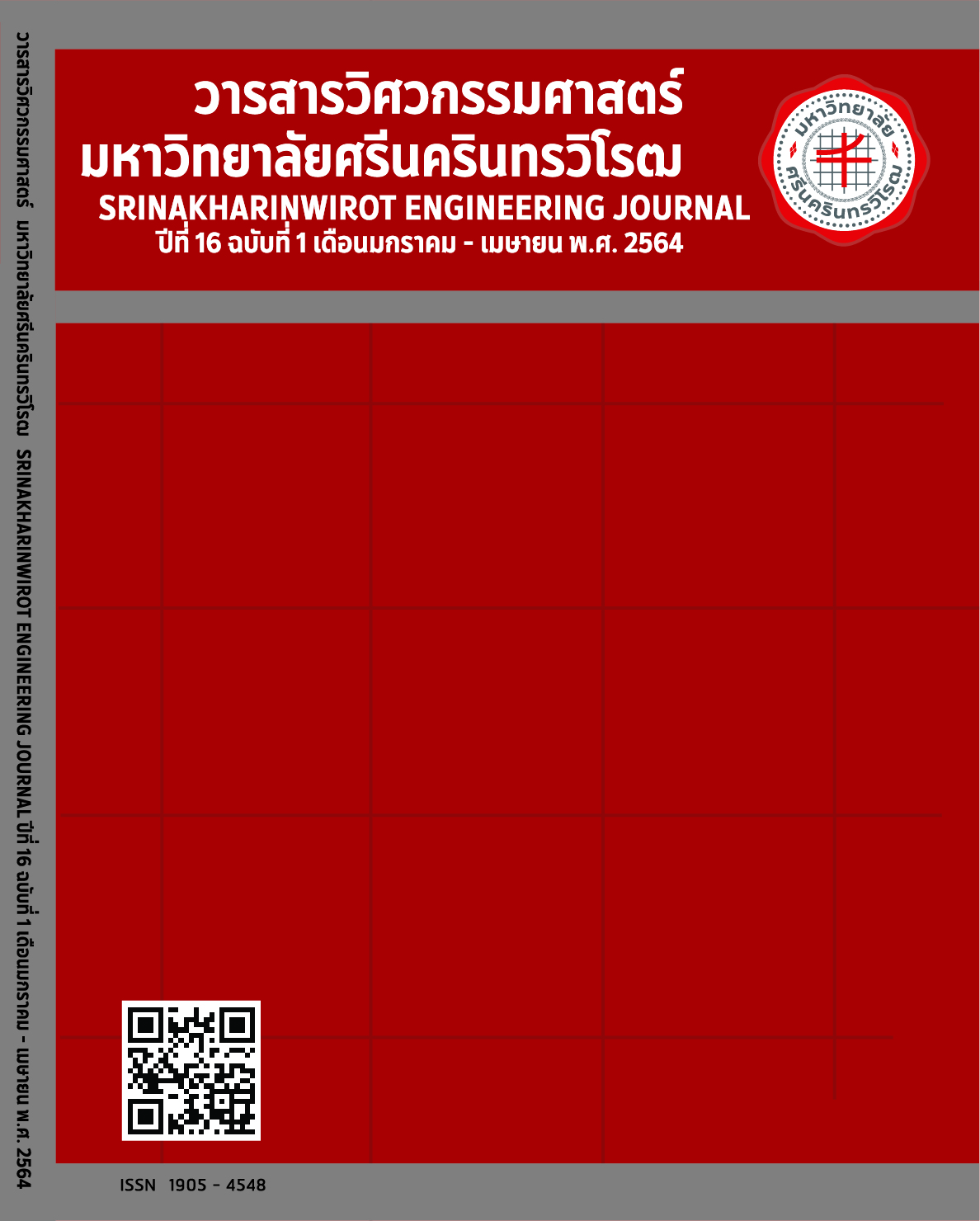Applications of Natural Latex as Additive for Soil Cement Block Production
Main Article Content
Abstract
This article aims to study the impacts on the soil cement block from using natural latex additive as an admixture. Experiments were performed on soil cement blocks using two different types of soil, laterite and sandy loam. The soil cement block samples were prepared using different volumes of natural latex as admixture at 0, 2, 4, 5, 6, 8 and 10 percent by weight of water. The properties of soil cement blocks were assessed against Thai Community Product Standards, TCPS 602/2547. The results found that the soil cement blocks produced using finely crushed laterite enhanced with 5 percent of natural latex additive had the highest compressive strength at 10.96 MPa. This was significantly higher than the compressive strength of soil cement block without additive at the level of 0.05 and consists of all the other properties according to the standard of the load-bearing bricks. The soil cement block that uses sandy loam which has no plastic limit properties, showed crack failures after press processed. The sample was improved using 5 percent natural latex then the property of the enhanced soil cement block showed improved properties and physical characteristics, there was no more crack failure and the product consisted of all the required characteristics of non-load baring bricks. The analysis of the results from this research indicated that the mechanical properties of soil cement blocks were improved with added natural latex at 5 percent, it has statistically significant higher compression strength. The natural latex was also acted as the binding agent which enabled the soil cement block to be press processed without cracks. This was clearly evident for cases where the soil were well graded mixture, especially for sandy loam. However, the properties of soil cement blocks were primarily dependent on the type of soil and the volume of cement used in the production process.
Article Details

This work is licensed under a Creative Commons Attribution-NonCommercial-NoDerivatives 4.0 International License.
Copyright belongs to Srinakharinwirot University Engineering Journal
References
W. Chantarakul and A. Chantanee, “Problems and Solutions for Rubber Price fall,” Rajapark Journal, vol.14, no.33, pp.132-140, March-April 2020.
Matichon Online. (2017, Dec 27). The Problem of Rubber Requires Analysis of The Causes and Laying Out The Correct Solutions: By Dumrong Leenanuruksa [Online]. Available: https:// matichon.co.th/columnists/news _779160
Rubber Authority of Thailand. (2019, Oct 24). Summary of The Situation of Rubber Prices in Q3/2019 and Trends in Q4/2019 [Online]. Available: https://www.sritranggroup.com/ misc/filemanager/source/2019/20191024-sta-news1-th.pdf
J. Saowapakpiboon, Dennes T. Bergado and T. Kritpuckkrapong, “Increasing Engineering Properties of Laterite Soil by Using Portland Cement Type 1 and Chemroad” in the 15th National Convention on Civil Engineering, Ubon Ratchathani, Thailand, 2010.
P. KHEAW-ON, “Compressive and Flexural Strengths of Recycled Pavement Base Material Stabilized with Cement and Admixtures,” M.S. thesis, Civil Engineering, Suranaree University of Technology, Nakhon Ratchasima, Thailand, 2013.
S. Chareonwutirap, K. Hareonwutirap, D. Singhasanee, C. Kongker and I. Phummiphan, “Marginal Pavement Materials Stabilized with Portland Cement and Chemical Polymer Solution,” in the 20th National Convention on Civil Engineering, Chonburi, Thailand, 2015.
W. Laoangjan, and S. Srijan, “The Study Guide to Behavior of Silty Sand Soil Using High Ammonia Natural Rubber Mixing for Landslide Protection,” in the 14th National Convention on Civil Engineering, Nakhon Ratchasima, Thailand, 2009.
P. Plangoen, “Application of Rubber Latex and Soil Cement Develop Drought Relieving Water Pond,” Engng.J.CMU, vol.25, no.2, pp.170-180, May-August 2018.
S. Pahusuwanno, K. Inkliang, and B. Hanhongart, “A Study of Para Soil Cement Road Construction,” in the 11th THAICID National Symposium, Nonthaburi, Thailand, 2018, pp. 265-276.
J. Phetvipat, “Legend of Soil Cement Block and Interlocking Block Part 2,” Witthayasat lae Theknoloyi, vol.21, no.2, pp.57-62, April-June 2006.
S. Seangatith, “Testing for Mechanical Properties of Soil-Cement Brick and Comparing with Masonry Bricks,” Suranaree Journal of Social Science, vol.6 no.2, pp.97-103, May-August 1999.
W. Kaewsaeng, “Mechanical Behaviour of Cement Stabilized Rammed Earth (CSRE) under Flexural Load,”in the 9th KU-KPS Conference, Nakhon Pathom, Thailand, 2012, pp. 1733-1742.
S. Saramakom, “Usage of Fly Ash for Manufacturing Interlocking Block,” M.S. thesis, Civil Engineering, Suranaree University, Nakhon Ratchasima, Thailand, 2013.
C. Charoennatkul, “Interlocking Blocks Containing Oil Palm Ash and Shells Waste,” Journal of Community Development and Life Quality, vol.2, no.1, pp.103-112, January-April 2014.
V. Sangrutsamee, “Development of Lightweight Interlocking Blocks from Paper Pulp Waste,” in Built Environment Research Associates Conference (BERAC 3), Thailand, 2012, pp.12-20.
Thai Community Product Standards for Interlocking Block, TCPS 602/2547, 2004.
Standards for Highway Construction for Soil Cement Subbase, DS.-H 206/2532, 1989.
Thai Industrial Standard for Sampling and Testing Concrete Masonry Units TISI 109-2517, 1974.


